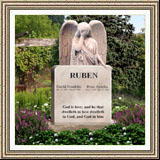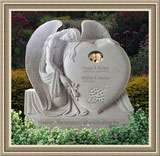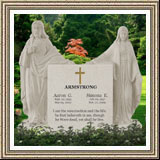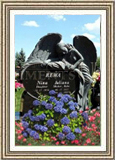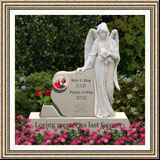|
Symbolism on Gravestones
by Jessie Lie Farber
What is the meaning of the designs carved on old
gravestones? This question is often asked by both the
interested layman and the serious student of gravestone
art. A great deal of casual speculation and considerable
scholarly research have been devoted to finding answers.
Speculative interpretations of some of the more obvious
designs can safely be made by the insightful observer.
The winged hourglass, for example, tells us that time
flies; the hourglass on its side, that time has stopped
for the deceased; the broken flower or tree, that life
has been cut short. Hundreds of other designs invite
this kind of easy, simplistic interpretation, and a
number of lists have been prepared which suggest to the
reader what the symbol probably means. The best of these
is included in a handsome book of gravestone photographs
by Francis Duval and Ivan Rigby, Early American
Gravestone Art in Photographs.
Unfortunately, not all designs on gravestones can be
interpreted in such a neat, uncomplicated way, and
attempts to do so are fraught with the likelihood of
error. Professional scholars disagree sharply about the
meaning of particular designs; they even debate the
extent to which it is possible to determine their
meaning and significance. This healthy diversity of
opinion stimulates interest and further study.
Because there are few simple answers, you should, if you
are interested in the symbolism on old gravestones,
approach the subject with an open, inquiring attitude
laced with a healthy skepticism. Familiarize yourself
with varying scholarly opinions. Read literature about
the work of individual carvers and about the life of the
period. And most important, study the stones themselves.
With patience and perseverance you will develop a good
background and understanding of this fascinating
subject.
FAQs on Symbolism
Here are several sources and interpretations for some
frequently used symbols on gravestones. There is more
than one interpretation for some symbols so
interpretations must be used as possibilities, not
certainties.
General Gravestone Symbolism
See Clasped Hands: Symbolism in New Orleans Cemeteries,
by Leonard V. Huber, published 1982 by the Center for
Louisiana Studies, University of Southwestern Louisiana.
It is fully illustrated and deals only with gravestones
and tombs.
Fraternal Symbolism
See "Fraternal Organizations" by Alvin J. Schmidt from
The Greenwood Encyclopedia of American Institutions,
published by Greenwood Press, 1980, or see The
International Encyclopedia of Secret Societies &
Fraternal Orders by Alan Axelrod, published by Facts on
File, 1997 or see Markers XI, "Ritual Regalia, and
Remembrance: Fraternal Symbolism" by Laurel K. Gabel.
Woodmen of the World
Woodmen of the World derived from the Modern Woodmen of
America, a fraternal group which was founded in 1883.
Fraternal scholar William Whalen describes it as an
insurance society with some fraternal lodge features.
Woodmen advertised themselves as an organization for the
"Jew and Gentile, Catholic and Protestant, the agnostic
and atheist." The Woodmen of the World emblem is a
sawed-off tree stump, often with a mallet or beetle, an
ax, and a wedge: the motto "Dum, Tacet Clamat" (Though
Silent He speaks") usually appears somewhere on the
border. These Woodmen emblems are found throughout the
United States, but the largest concentration is in the
South and Midwest.
Mortuary Carriages
In the 19th century some larger urban areas had
pallbearer or mourners' coaches. These would be the
equivalent of a limousine today, but they certainly had
features that separated them from an everyday coach. You
may want to look up www.hearse.com on the Internet. They
have photographs of funeral coaches of every size and
may have a pallbearer's coach. There is also a national
mourning collectors group.
Mourning cards
Generally most mourning cards are black with gold
lettering. Some have generic images, like a dove,
flowers, etc. They were used as family mementos and may
have been incorporated into a large piece. Some
companies produced large lithographs with various
mourning iconography, angels, doves, flowers, biblical
verses, and there was a spot to place the mourning card
within the lithograph. The whole thing was then hung on
the wall. I have seen mourning cards in photographs
taken of the flower arrangements from the funeral. The
photographer propped the cards up near the flowers. I
have seen these cards used in shadowbox frames with
other artifacts from the person and their wake. The
whole thing was then hung on the wall in tribute to
them.
Shells
Clam shells, scallop shells, and other types of shells
are a symbol of a person's Christian pilgrimage or
journey through life and of baptism in the church. In
the middle ages, Christians wore the scallop shell to
indicate that they had made a pilgrimage to the shrine
of St. James of Compostella in Spain. Placing a shell on
a gravestone when visiting the site is an ancient custom
and may in fact have several different meanings
depending on the cultural background of the people
placing the shells. The idea of crossing over a body of
water to the promised land or crossing the River of Styx
to the afterlife, the final journey to the "other side"
is also part of the symbolism of the shell.
Hands
Hands are found on many gravestones. It may be the hand
of God pointing downward signifying mortality or sudden
death. The hand of God pointing upward signifies the
reward of the righteous, confirmation of life after
death. Praying hands signify devotion. Handshakes may be
farewells to earthly existence or may be clasped hands
of a couple to be reunited in death as they were in
life, their devotion to each other not destroyed by
death.
Some initials found on gravestones:
FLT stands for Friendship, Love, Truth, three degrees
associated with the Independent Order of Odd Fellows.
The Odd Fellows, first organized in the US in 1819, is a
popular fraternal/benefit organization. The emblem of
the Odd Fellows is usually shown as three links of a
chain. A number on the stone is the local lodge number.
FCL stands for Fraternity, Charity, and Loyalty. These
same letters were also used by the Daughters of Union
Veterans of the Civil War and a similar hereditary group
called the Ladies of the Grand Army of the Republic.
The Obelisk
The obelisk is, to quote McDowell and Meyer in The
Revival Styles in American Memorial Art, one of the
"most pervasive of all the revival forms" of cemetery
art. There is hardly a cemetery founded in the 1840s and
50s without some form of Egyptian influence in the
public buildings, gates, tomb art, etc. Napoleon's
1798-99 Egyptian campaigns, the discoveries at the tombs
of the Pharaohs, and our new Republic's need to borrow
the best of the ancient cultures (Greek revival, classic
revival, the prominence of classical studies and dress,
etc.) led to a resurgence of interest in the ancient
Egyptian culture. Obelisks were considered to be
tasteful, with pure uplifting lines, associated with
ancient greatness, patriotic, able to be used in
relatively small spaces, and, perhaps most importantly,
obelisks were less costly than large and elaborate
sculpted monuments. There were many cultural reasons for
the revival styles of the nineteenth century.
Freemasonry, while part of the overall cultural
influence, was not responsible for the prevalence of
obelisks. If you would like to read more about some of
these styles, see The Egyptian Revival: Its Sources,
Monuments and Meaning, 1808-1859, by Richard Carrott.
What is the origin of the practice of all headstones
facing east?
In many, but by no means all, early New England burying
grounds the graves are positioned east/west. This
east/west orientation is the most common orientation in
other parts of the country and world as well. The
earliest settlers had their feet pointing toward the
east and the head of the coffin toward the west, ready
to rise up and face the "new day" (the sun) when "the
trumpet shall sound and the dead shall be raised" or
when Christ would appear and they would be reborn. If
the body was positioned between the headstone and the
footstone, with the inscriptions facing outward, the
footstone might actually be facing east and the
decorated face of the headstone facing west. If the
headstone inscription faces east, the body would most
commonly be buried to the east of it. Much depends on
the layout of the graveyard -- if there was a church or
other building in the center of the burial site, where
the high ground was located, the location of access
roads, etc. Early graves were seldom in the neat rows
that we are used to seeing. Burials were more haphazard,
more medieval in their irregularity; families didn't own
plots and burial spaces were often reused. The north
side of the cemetery was considered less desirable and
is often the last part of the burying ground to be used,
or you may find the north side set aside for slaves,
servants, suicides, "unknowns," etc. In many burial
grounds graves face all four points on the compass.
Sometimes a hilly site will have stones facing all four
directions. With the coming of the Rural Cemetery
Movement in the 1830s and 40s, an entirely new style of
burial became popular. The ideal of winding roads and
irregular terrain dictated the orientation of the
monuments to a large degree. |

